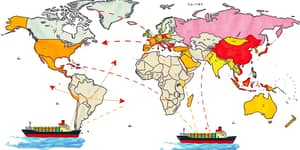
In 2025, the world economy faces a new crucible of challenges as exchange rates ebb and flow with unprecedented intensity. Across continents, businesses and policymakers alike are forced to confront hidden fragilities that ripple through sectors, markets, and entire regions. From the corridors of central banks to the floors of garment factories, the effects of a surging U.S. dollar and weakening emerging market currencies are both profound and startling.
As global trade growth is revised sharply downward, regions must navigate a landscape of risk and opportunity. This article delves into the forces driving currency volatility, the specific vulnerabilities that emerge, and the strategic measures needed to transform peril into potential.
According to the IMF and WTO, global trade growth in 2025 is projected at a mere 1.7%, down sharply from earlier forecasts. This mark reflects systemic strains, chief among them persistent exchange rate volatility that disrupts cross-border commerce and investment decisions. In a world where price signals matter more than ever, sudden FX swings can stall shipments, inflate costs, and erode profit margins across supply chains.
With new tariffs and policy uncertainties on the rise, countries that once relied on stable trade relationships must now build robust mechanisms for risk management. Whether through financial hedging, contractual adjustments, or diplomatic coordination, the imperative is clear: adapt quickly or face compounding losses.
The United States, forecast to grow at 2.7% in 2025, enjoys the benefits of a strong currency. For importers, cheaper dollar-priced goods help contain inflation and expand consumer choice. Yet for exporters, the same phenomenon can mute profitability. A stronger dollar demands that U.S. producers either absorb slimmer margins or hike prices, risking market share in a fiercely competitive global environment.
Central bank actions add another layer of complexity. As the Federal Reserve calibrates interest rates, even minor shifts reverberate worldwide. Firms operating across borders must monitor these policy signals closely to maintain healthy cash flows and competitive positioning.
For many developing economies, the confluence of dollar strength and domestic challenges has created acute stress. Currency depreciation can boost export competitiveness, but it also throws import costs sharply upward, especially for energy, electronics, and essential raw materials. The result: sudden spikes in input prices and inflationary pressures that squeeze household budgets and corporate balance sheets.
These trends illustrate a broader phenomenon: dollar-denominated debt burdens become heavier as local currencies weaken, undermining both public and private sector viability. Where central banks once relied on monetary credibility, unpredictability now reigns.
Within this shifting mosaic, certain industries find themselves on divergent paths. Export-oriented firms in chemicals and steel may gain market share abroad, yet simultaneously face sharply increased costs for imported machinery and technology. Conversely, import-centric sectors—automotive parts, consumer electronics, pharmaceuticals—grapple with eroding margins as procurement expenses climb.
Financial institutions, too, encounter a dual challenge. They must safeguard balance sheets against non-performing loans in foreign currency, while ensuring adequate liquidity for trade financing. In this high-stakes environment, trade finance hedging strategies are no longer optional, but rather foundational to corporate survival.
Faced with fluctuating exchange rates, governments and businesses must proactively shore up defenses. Central banks may intervene directly in FX markets or employ interest rate adjustments, yet these tools often yield only temporary relief. A more sustainable approach involves a combination of financial, operational, and policy-driven tactics.
At the corporate level, integrating currency risk assessment into strategic planning can yield significant benefits. By stress-testing scenarios and adopting supply chain diversification measures, firms can minimize disruption and capitalize on favorable shifts.
Currency fluctuations are less a temporary storm than a new normal in the interconnected 2025 economy. Regions and sectors that cultivate adaptability, innovation, and strategic foresight will not only survive but potentially emerge stronger. The key lies in viewing FX volatility not as a threat alone, but as a catalyst for transformation.
From agile hedging frameworks to resilient domestic industries, the playbook for success demands both technical rigor and creative vision. As global trade growth hums modestly, the true measure of progress will be which economies learn to harness the winds of change, turning vulnerability into advantage through building long-term resilience and strategic unity.
References













